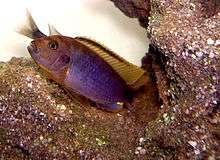Iodotropheus sprengerae
Iodotropheus sprengerae, the rusty cichlid, lavender mbuna or lavender cichlid, is a species of cichlid endemic to the Boadzulu and Chinyankwazi Islands and Chinyamwezi Island regions of Lake Malawi. It prefers a temperature range of 24-26 °C.[2]
| Rusty cichlid | |
|---|---|
 | |
| Scientific classification | |
| Kingdom: | Animalia |
| Phylum: | Chordata |
| Class: | Actinopterygii |
| Order: | Cichliformes |
| Family: | Cichlidae |
| Genus: | Iodotropheus |
| Species: | I. sprengerae |
| Binomial name | |
| Iodotropheus sprengerae M. K. Oliver & Loiselle, 1972 | |
| Synonyms | |
|
Iodochromis sprengerae (Oliver & Loiselle, 1972) | |
Rusty cichlids are elongate fish that can grow up to 10.8 centimetres (4.3 in) SL.[2] Juveniles and females are rusty brown color, while mature males have lavender purple hue.
Rusty cichlids are mouthbrooders. Females hold their fertilized eggs and fry, in their mouth for a few weeks before releasing the fry.
Rusty cichlids are endemic to Lake Malawi where it is apparently restricted to islands and reefs in the southeastern arm of the lake. The restricted distribution and the effects of the aquarium trade and increased sedimentation on this fish are unknown. The IUCN list tis species as Near Threatened.[1]
This species is named in honour of Kappy Sprenger, an aquarist, author and artist from Los Gatos, California,whose efforts to have this fish correctly identified led to the realisation that this was an undescribed species.[3]
Aquarium care
Although not entirely a peaceful fish, the rusty cichlid is considered one of the least aggressive among the mbuna cichlids. This quality makes rusty cichlids an ideal starter fish for aquarists with less experience keeping the mbuna. Hiding places and space should be provided or this fish will be bullied by their more aggressive tank mates. Rusty cichlids are omnivorous and will eat various kinds of food, but meaty food can often cause them serious digestive problems.
References
- Konings, A. (2018). "Iodotropheus sprengerae". IUCN Red List of Threatened Species. 2018: e.T120695830A120695944. doi:10.2305/IUCN.UK.2018-2.RLTS.T120695830A120695944.en.
- Froese, Rainer and Pauly, Daniel, eds. (2013). "Iodotropheus sprengerae" in FishBase. February 2013 version.
- Christopher Scharpf & Kenneth J. Lazara (21 August 2018). "Order CICHLIFORMES: Family CICHLIDAE: Subfamily PSEUDOCRENILABRINAE (h-k)". The ETYFish Project Fish Name Etymology Database. Christopher Scharpf and Kenneth J. Lazara. Retrieved 14 December 2018.
